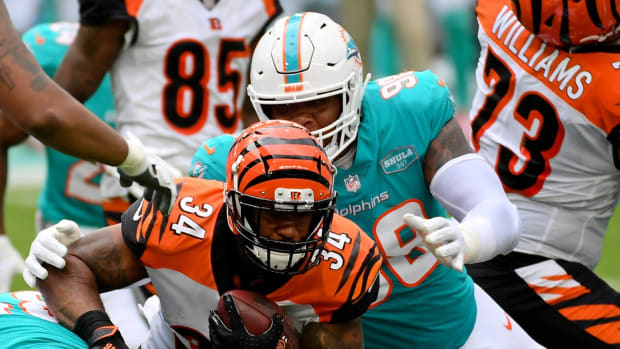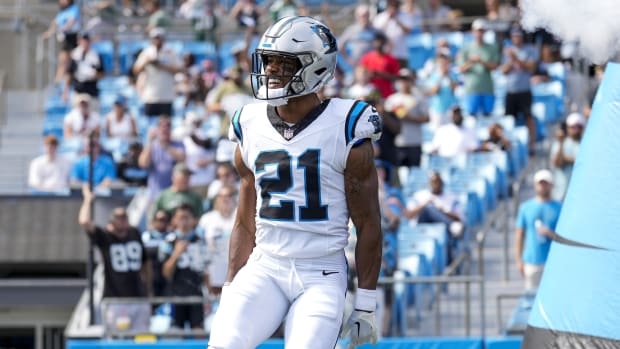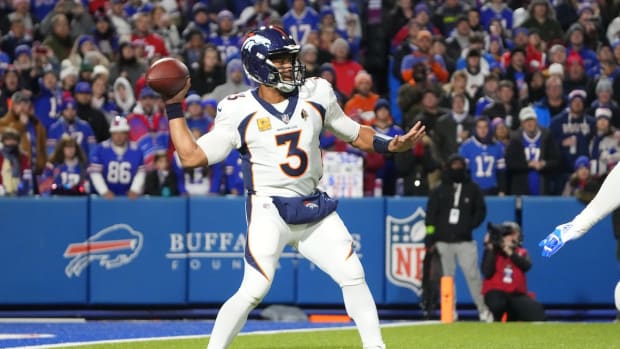Timeline: Six Studies of Head Trauma in Football That Helped Establish Link to CTE
A highly–publicized study published Tuesday in the Journal of the American Medical Association (JAMA) found evidence of chronic traumatic encephalopathy (CTE) in 110 out of the 111 studied brains of former NFL players.
CTE occurs when repeated head trauma leads to the buildup of "tau," an abnormal protein, in the brain. Tau negatively effects how the brain's blood vessels function and eventually erodes nerve cells themselves. Symptoms, which generally do not manifest until years after the repeated trauma, range from mood disorders on the more mild end to crippling dementia in more serious cases.
That the NFL has a head trauma problem isn't news to anyone—the 2015 film Concussion, chronicling the life of Dr. Bennet Omalu, who discovered CTE for the first time in a football player, publicized the issue even beyond sports fans—but the most recent study is the latest evidence that football can lead to traumatic brain injury.
Warren Sapp to donate brain for research on concussions, head trauma
Even though we still have a lot to learn about how football affects the brain, McKee's latest study was far from the first to suggest a link between the sport and CTE. Still, the link hasn't always been so widely accepted. For years, the NFL fought back—mainly through its paradoxically named Mild Traumatic Brain Injury committee—with shoddy studies aiming to counter mounting evidence that repeated blows to the head causes long-term cognitive and neurological dysfunction. The NFL acknowledged the link between football and CTE for the first time just last year.
Here's a look back at some of the most influential studies examining how head trauma affects NFL players.
March 1997
A study published by the American Academy of Neurology states that repeated concussions can cause brain damage. The study lays out three Grades of concussions: Grade 1 is characterized by "transient confusion," no loss of consciousness and symptoms that lass less than 15 minutes; Grade 2 by the same criteria as Grade 1 except symptoms last more than 15 minutes; Grade 3 by any loss of consciousness. The study sets out guidelines for when a player should or should not return to the field. It would be three more years before researchers examined how head injuries affected a group of ex-pro football players.
First two claims in NFL concussion settlement total $9 million
May 2000
At an annual meeting of the American Academy of Neurology, Dr. Barry Jordan and Dr. Julian Bailes present the first survey of head injuries in former professional football players. The study, which was funded by the NFL Players Association, surveyed 1,090 former players. According to the self-reported surveys, 60 percent of the players had suffered at least one concussion and 26 percent reported suffering at least three concussions. The survey administered questions on a wide range of health topics, and the players were not informed that the purpose was to examine neurological effects in an attempt to avoid over-reporting of symptoms.
Players that suffered at least one concussion were found to be more likely to experience neurological symptoms than those who did not suffer a concussion. These symptoms include problems with memory and concentration, confusion, speech or hearing difficulties, numbness or tingling in extremities, and headaches.
May 2007
Dr. Kevin Guskiewicz and Bailes, who together authored a 2005 study linking concussions with early-onset Alzheimer's disease, publish the results of another survey of 2,552 players in Medicine & Science in Sports & Exercise. The survey, which was administered as a general health questionnaire, examined former players whose average age was 53.8 and whose average professional football career lasted 6.6 years. Compared with players who reported suffering no concussions, players who suffered at least one concussion were 1.5 times more likely to be diagnosed with depression, while players who suffered at least three concussions were three times more likely to receive that diagnosis.
September 2009
Researchers at the University of Michigan's Institute for Social Research publish a study funded by the NFL Players Care Foundation. The survey of 1,063 players asked a broad range of questions and was aimed at painting a general picture of retired players' post-NFL life. While the final report suggests that playing in the NFL was a "very positive experience for most retired players," the report does acknowledge that surveyed retirees aged 30-49 were 19 times more likely than the general population to have been diagnosed with dementia, Alzheimer's or other memory-related diseases. More than six percent of retirees over 50 had been given that diagnosis, compared with just 1.9 percent of the general population of men that age.
Supreme Court leaves $1B NFL concussion settlement in place
September 2012
In September 2012, researchers from the CTE Center at Boston University publish a study in Brain: A Journal of Neurology documenting 15 cases of CTE in the brains of former NFL players. While this isn't the first to link CTE with ex-NFLers—Omalu observed CTE in the brain of former Steeler and Hall of Famer Mike Webster in 2005—the study more than doubles the number of documented cases of CTE in former football players. The study acknowledges a large selection bias, as the work is made possible by NFL players who donate their brains for posthumous research, ostensibly motivated by the belief that they're suffering neurological dysfunction.
July 2017
By this point, the link between football and CTE is well-known and widely accepted in the scientific community. Further cementing the link, BU's CTE Center expands on its 2012 and 2014 work (the latter of which found CTE in 76 of 79 studied brains), announcing the results of a study of 202 deceased football players' brains. Of the 111 brains of former NFL players that were examined, researchers find evidence of CTE in 110. The study looks at the brains of players as young as 23 and as old as 89 and includes players of all positions. The study also suggests that a longer football career can lead to more severe cases of CTE, as brains of deceased men who stopped playing had less severe cases than those who played professionally. Authors of the study acknowledge the same selection bias, as the brains studied were donated by players for neurological research.
"This not a population-based sample and these numbers aren't the prevelance of this disease in the general population of football players," co-author of the study Dr. Jesse Mez toldSports Illustrated. "What this study does establish well is that there is likely a connection between football and CTE."




































